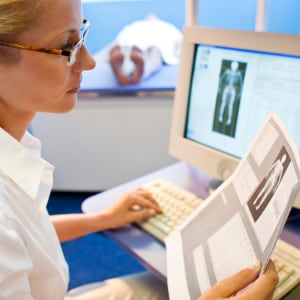Health and Care of Bones Across the Lifespan Part 2: Are there any good habits for the care of bones?
Last week, I discussed what bone is and why calcium matters. For my final installment in this series, I shed light on exercise, calcium and vitamin D daily recommendations, and DEXA scans.
 Exercise is important
Exercise is important
My mantra is “exercise is medicine.” In fact, the stress associated with exercise plays a key role in keeping our bones in shape. Exercise positively influences bone density by augmenting mineral deposits, which fights osteoporosis.
The American College of Sports Medicine suggests 10 to 20 minutes of weight-bearing exercises twice daily, 3 to 5 days per week. Some good activities include walking, jogging, stepping, jumping rope, or stair climbing. Resistance exercises performed with manageable weights are likewise favorable. A good exercise plan keeps us agile, which in turn makes us less susceptible to falls and fractures.
Calcium and Vitamin D
To further promote the care of bones, the National Osteoporosis Foundation recommends a daily level of 1,000 milligrams (mg) of calcium for women age 50 or younger as well as for men age 70 or younger. However, a daily amount of 1,200 mg is recommended for women older than age 50 and for men older than age 70.
Note that women are encouraged to increase their calcium intake at a younger age than men because estrogen levels drop during menopause. Estrogen is considered a fairly strong osteoprotective hormone. It inhibits osteoclasts from outpacing osteoblasts in the normal cycle of bony remodeling. However, too little levels of testosterone in men can end up being anti-osteoprotective, and therefore lead to bone loss.
As for sufficient amounts of vitamin D, 400 to 800 international units (IU) are needed per day for adults age 50 and younger. At 51 years of age, 800 to 1,000 IU per day are recommended. The best source of vitamin D comes from direct conversion in the body due to sunlight exposure. However, both fish and eggs offer their own unique sources of this vitamin. And while all dairy foods contain calcium, the Food and Drug Administration ensures that fluid milk (and breakfast cereals) are vitamin D fortified.
DEXA Scanning
 The gold standard for testing bone density is DEXA scanning. This test is simple to conduct using a special x-ray machine, as well as comfortable and extremely safe for individuals to undergo. DEXA stands for dual energy x-ray absorption. Although an initial scan evaluates the likelihood for developing osteoporosis, scans repeated every two years will assess steps taken to improve your bone density. If necessary, adjustments in your overall approach can always be made. Knowledge is a powerful motivator.
The gold standard for testing bone density is DEXA scanning. This test is simple to conduct using a special x-ray machine, as well as comfortable and extremely safe for individuals to undergo. DEXA stands for dual energy x-ray absorption. Although an initial scan evaluates the likelihood for developing osteoporosis, scans repeated every two years will assess steps taken to improve your bone density. If necessary, adjustments in your overall approach can always be made. Knowledge is a powerful motivator.
The National Osteoporosis Foundation recommends DEXA scans for women who are age 65 or older, men who are age 70 or older, and for men or women if a bone is broken after age 50. In addition, DEXA scans are specifically warranted if a bone break or a bone loss, or both, is mentioned after a regular x-ray of your spine. Finally, results from DEXA testing are useful if you lose 1 inch of height within 1 year or 1.5 inches of your maximal height during your lifetime.
With a physician referral, a radiology technologist from Imaging Services at Fisher-Titus Medical Center will conduct a DEXA scan to assess your bone density. Similarly, dieticians from Nutrition Services and exercise specialists from Rehabilitation Services will gladly review diet and exercise strategies to minimize bone density loss.
About Kevin
Kevin Wininger is as a radiology technologist and exercise physiologist at Fisher-Titus Medical Center. With an appropriate physician referral, a radiology technologist in Fisher-Titus’ Imaging Services will conduct a DEXA scan to assess your bone density. Similarly, dieticians from Nutrition Services and exercise specialists from Rehabilitation Services will gladly review diet and exercise strategies to minimize bone density loss.
